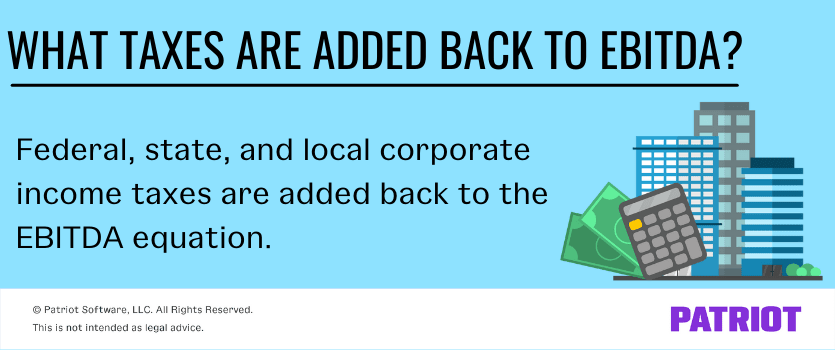When learning how to calculate the valuation of your company, you probably learned about EBITDA. The information in the EBITDA formula is important when calculating your profitability and overall financial performance. But earnings before interest, taxes, depreciation, and amortization (aka EBITDA) hit a snag regarding the specific taxes you should include. And, what taxes you should exclude.
So, what taxes are added back to EBITDA? And, what taxes should you remove from the equation?
What taxes are added back to EBITDA?
When you already know the answer to What is EBITDA, it’s time to look at the taxes included in the equation. As a refresher, here is the EBITDA calculation:
EBITDA = Earnings + Interest + Taxes + Depreciation + Amortization
Business owners pay a number of taxes, including:
- Income
- Payroll
- Excise
- Self-employment
- Sales
- Use
…And the list goes on. So when it comes to knowing which taxes to include, it’s easy to confuse which taxes you should use in EBITDA.
EBITDA taxes are specifically income taxes, including:
- Federal
- State
- Local
Keep in mind that the income taxes in the EBITDA calculation are corporate income taxes, not the payroll incomes taxes for employees.

Why are not all taxes included in EBITDA?
So, why must you only include income taxes and not other taxes in your EBITDA formula? Income taxes are not a part of your company’s overhead or general operating expenses. The other taxes are expenses you must pay regardless of business income or structure.
Another reason you do not include these types of taxes in EBITDA is that most businesses pay these taxes.
For example, you must pay payroll taxes if you have employees. The cost of having employees is an expense that you account for each year. These expenses may fluctuate depending on the number of employees, raises, and other factors. But, the expense of payroll taxes is an overhead cost. Because the taxes are not linked directly to profits, do not include payroll taxes in EBITDA.
On the other hand, corporate profits can vary. As a result, so do the corporate income taxes you must pay. Because of the fluctuation in the amount of income tax your business pays, include the cost of these income taxes in your EBITDA calculation.
The bottom line: The taxes linked directly to profits are EBITDA taxes.
Where to find EBITDA tax information
Before you sit down to crunch some numbers, you need to know where to find the information needed for EBITDA taxes. You can find your EBITDA taxes on your profit and loss statement (aka P&L statement). Some companies label the specific line in their P&L as “Provisions for Income Taxes” to easily identify the taxes they need for EBITDA.
If you choose to use a single line item for all corporate income taxes, only use that line for the taxes portion of the calculation. Want a more clear idea of the cost of income taxes? You can also break them down into different line items, including:
- Federal corporate income tax
- State corporate income
- Local corporate income tax
Remember that separating the line items means you have to include all line items in the “taxes” part of the equation. And, include state corporate income tax for all states you perform business in. Why? Because you owe state income tax to all states you do business in.
The role of taxes in EBITDA
So, why do you add taxes back in EBITDA, and what is the role of taxes in the equation? You add the income taxes back so your EBITDA equation can reflect how much you pay in taxes more accurately. The more you pay in taxes, the higher your EBITDA.
The role of taxes in the equation is to align your company’s EBITDA ratio more closely with other companies in your business’s tax bracket.
But, there is a catch to adding these taxes back to the equation. That catch is your business structure.
EBITDA taxes and business structure
Again, you have taxes your business pays regardless of business structure. Do not include those taxes in EBITDA. But, what happens if your business has pass-through taxation? Do you include those income taxes in your calculation? Simply put, no.
If your business has pass-through taxation, you do not have corporate income tax. So, you do not include income taxes in your equation. Instead, you pay income taxes on your personal income tax returns instead of the business tax returns.
Businesses with pass-through taxation include:
- S corporations
- Sole proprietorships
- Limited liability corporations (LLCs) not taxed as corporations
- Partnerships
The business structure that does not have pass-through taxation is a C corporation. C corporations pay income taxes on their business tax returns and personal income tax returns. This method is called double-taxation. As a result, C corporations can include corporate income taxes in their EBITDA formula.
Some LLCs choose to be taxed as a corporation. When LLCs are taxed as a corporation, they are subject to double-taxation, too. In the case of LLCs taxed as a corporation, the LLC can include the business income tax in the EBITDA calculation.
If your business uses pass-through taxation, the taxes section of your EBITDA equation will be filled with a zero. Take a look at some examples.
Example 1
Let’s say your business is an S corporation with $50,000 in profits, $4,000 in interest, $2,000 in depreciation, and $1,500 in amortization. Because you are an S corporation, you have $0 in taxes. Your equation looks like:
EBITDA= $50,000 + $4,000 + $0 + $2,000 +$1,500
EBITDA = $57,500
Using EBITDA, your company’s valuation is $57,500.
Example 2
In this example, you have the same profits, interest, depreciation, and amortization as Example 1. But, your business structure is a C corporation with $5,000 in business income taxes. Your EBITDA equation looks like:
EBITDA = $50,000 + $4,000 + $5,000 + $2,000 + $1,500
EBITDA = $62,500
The valuation of your company is $62,500 using the EBITDA calculation.

